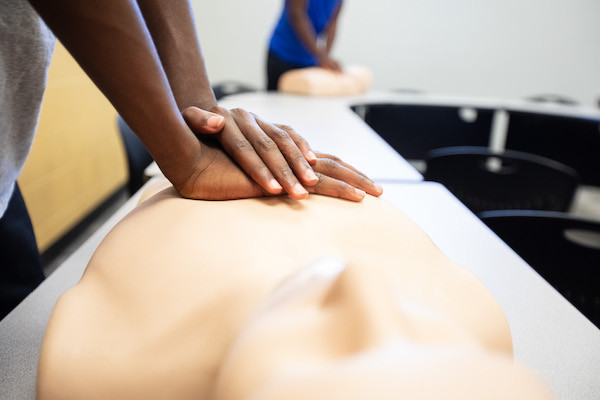What To Do In An Emergency

Today’s ‘hands-only’ CPR eschews mouth-to-mouth. Providers are in short supply – consider making life saving a career.
BREVARD COUNTY, FLORIDA – The cardiac arrests of young high-profile athletes Bronny James and Damar Hamlin has everyone, even young people themselves, asking, what would I do in that emergency?
Health First, with its mission of raising wellness for all across the Space Coast, has been spreading the message, and that brought Flight Nurse Rob Spivey, a veteran and program manager of Health First’s First Flight air ambulance, to the Boys & Girls Clubs of Central Florida’s Cocoa club with three mannequins and trainer AEDs (automated external defibrillator).
He took club members through exactly what to do in just such a case as James’ and Hamlin’s.
“The difference between a close call and a tragedy, maybe the loss of someone very close to you, could be what you learn right here, right now,” Spivey told the class.
As a trauma nurse and First Responder for the area’s only not-for-profit health system, Spivey considers it a duty to teach others in the community what he knows. He’s led dozens of local CPR trainings. On four separate occasions, he’s been approached by old students who have told him that they drew on the training in an emergency, and that their actions saved a life.

“First Flight responds to a number of serious accidents. On many of these calls, we see the difference a single person with lay-person CPR training can make when assisting with bystander aid before first responders arrive,” he said. “Knowing what to do the right way in that emergency can make a life-or-death difference.”
Spivey also took the occasion to talk to the class about considering a career in healthcare – specifically, as a physician or medical provider. Young people might think doctors and other advanced providers must be very good at math and science at a young age.
“Mostly, success in this profession has a lot to do with memorization and attention to detail. Are you good at memorizing and organizing things?” he asked the class. “You can be a very good doctor.”
“Boys & Girls Clubs offer members a safe after-school environment, but we see our role as greater than that. Here, they learned how to save a life,” said Erin
Harvey, Senior Development Officer for Brevard County’s Boys & Girls Clubs of Central Florida. “Even more than that, a successful professional came in and asked them to dream big. That’s meaningful. We want to show our members the community they’re about to go out and be a part of.”
One of the students, Ci’miya Davis of Cocoa, took the encouragement to heart. She told Spivey in class she was strongly considering training to be an ultrasound technician. But after, outside, she said Spivey’s encouragement made her want to explore the possibility of becoming a nurse in one of the armed services.
Not a doctor?
“It’s a lot of schooling, and doctors end up in debt – it’s just a lot,” she said. “But [nursing] is good because I want to help people, and you get to do a lot with that education.”

What To Do In An Emergency
In the event a person suddenly collapses, what exactly should people do?
Spivey advises “hands-only CPR,” which eliminates mouth-to-mouth respiratory resuscitation because, in an emergency, “the actual amount of oxygen we can get into the lungs and circulated with mouth to mouth is limited, and it’s more effective in this kind of emergency to circulate blood using good quality chest compressions, uninterrupted, until professional help arrives.”
He coached the students to do the following, in the following order.
■ CALL 9-1-1. Do this first. If another person is present who is not actively involved in resuscitation, have them call and talk to the operator.
■ CHECK for breathing and a pulse. You can check for breathing by visually confirming a chest that’s rising and falling, or by placing your hand just above the person’s mouth and nose. The best place to feel for a pulse is the side of the neck. In the event breathing and a pulse cannot be detected –.
■ BEGIN chest compressions. The pace is quick – about two beats per second – and the force is deep, at least two inches. Continue until help arrives.
If an AED is present, it should be retrieved and started. Most AEDs today feature an automated speaker who will take users through the steps of applying the
AED pads correctly and initiating a resuscitating jolt.
For more information on emergency CPR and AED use, or to sign up for a class, visit the Red Cross at RedCross.org and click Training & Certification.
The post Health First Mananger CPR Lesson Prepares Boys & Girls Club Members for Life-Saving Role appeared first on Space Coast Daily.
